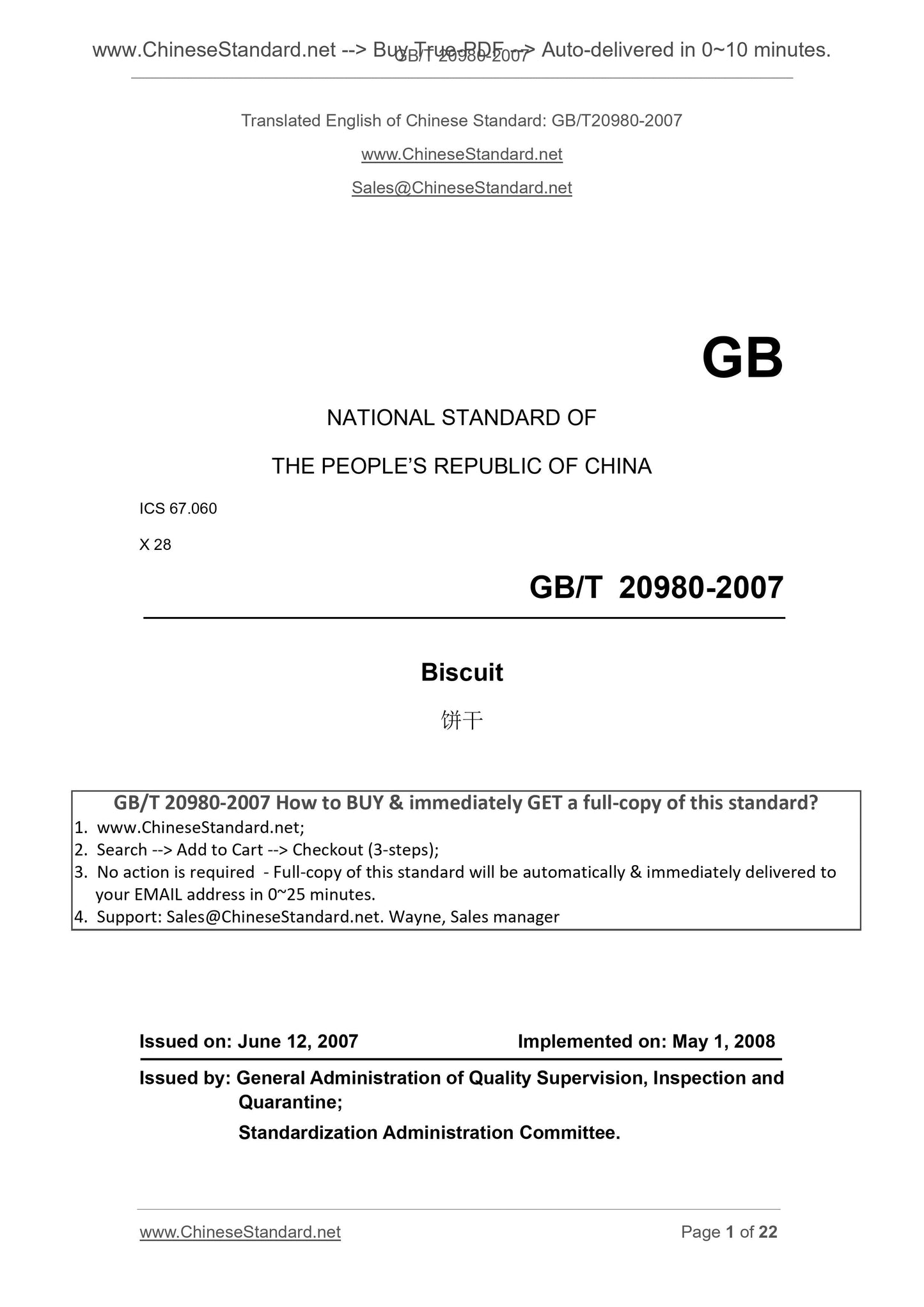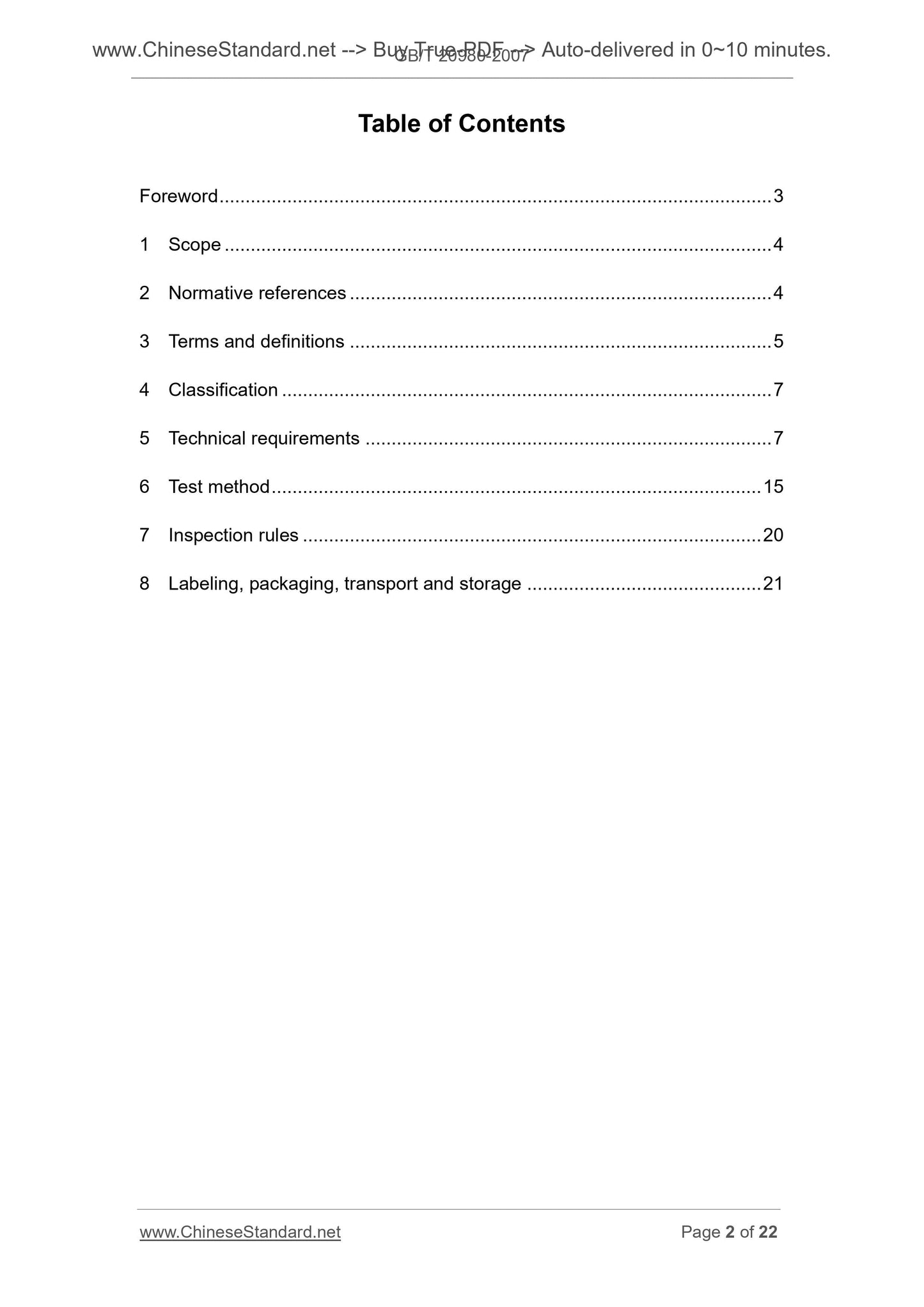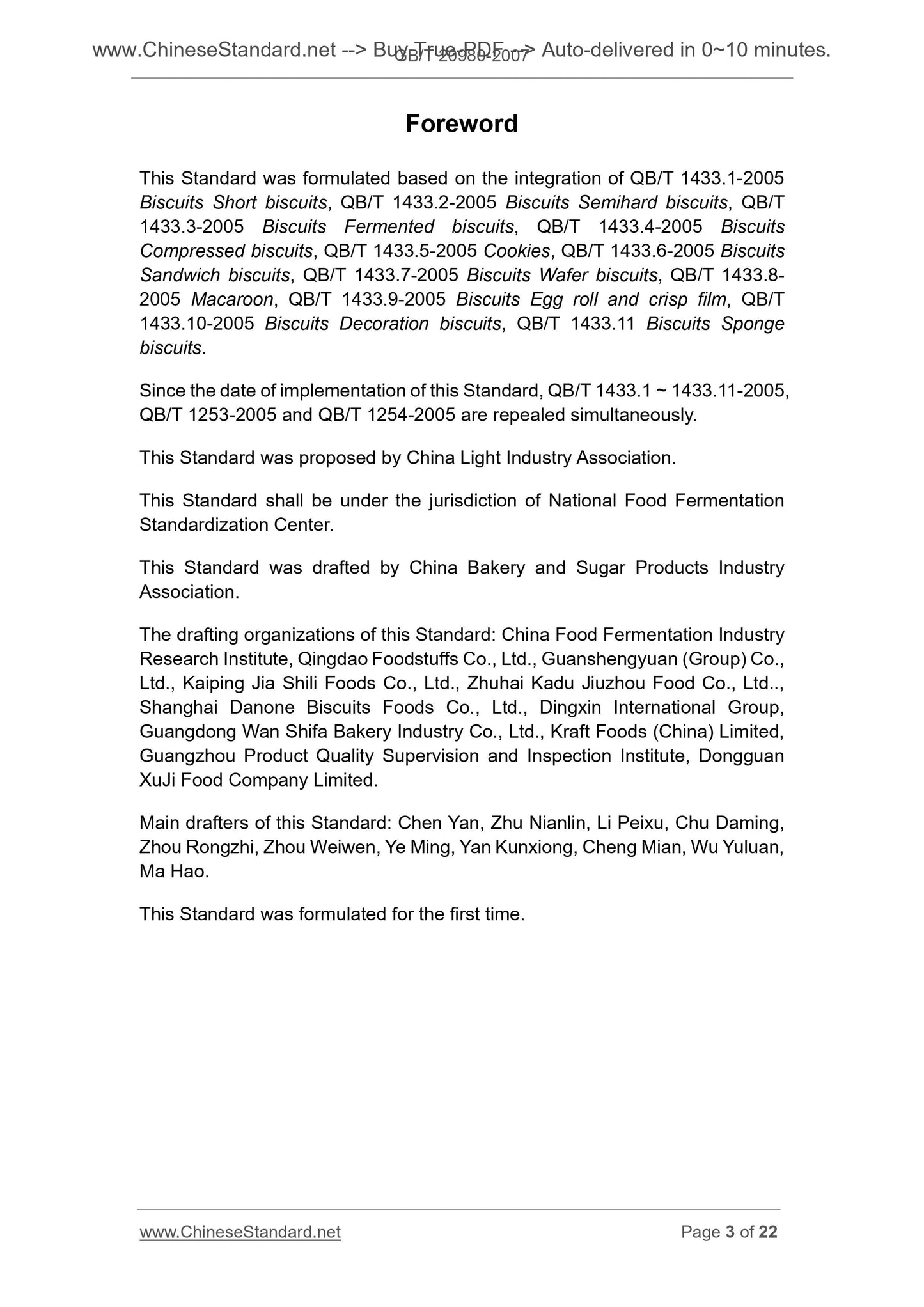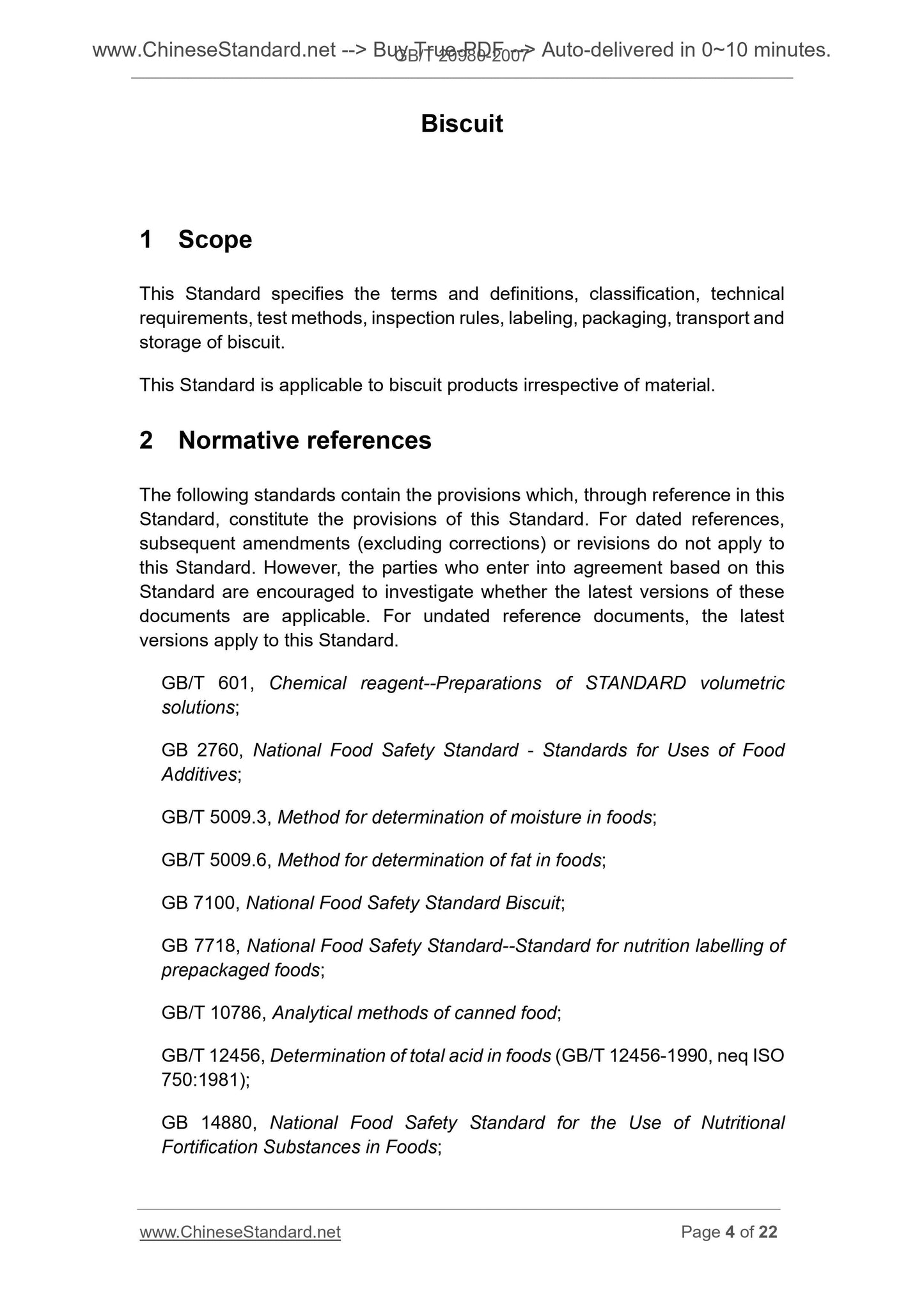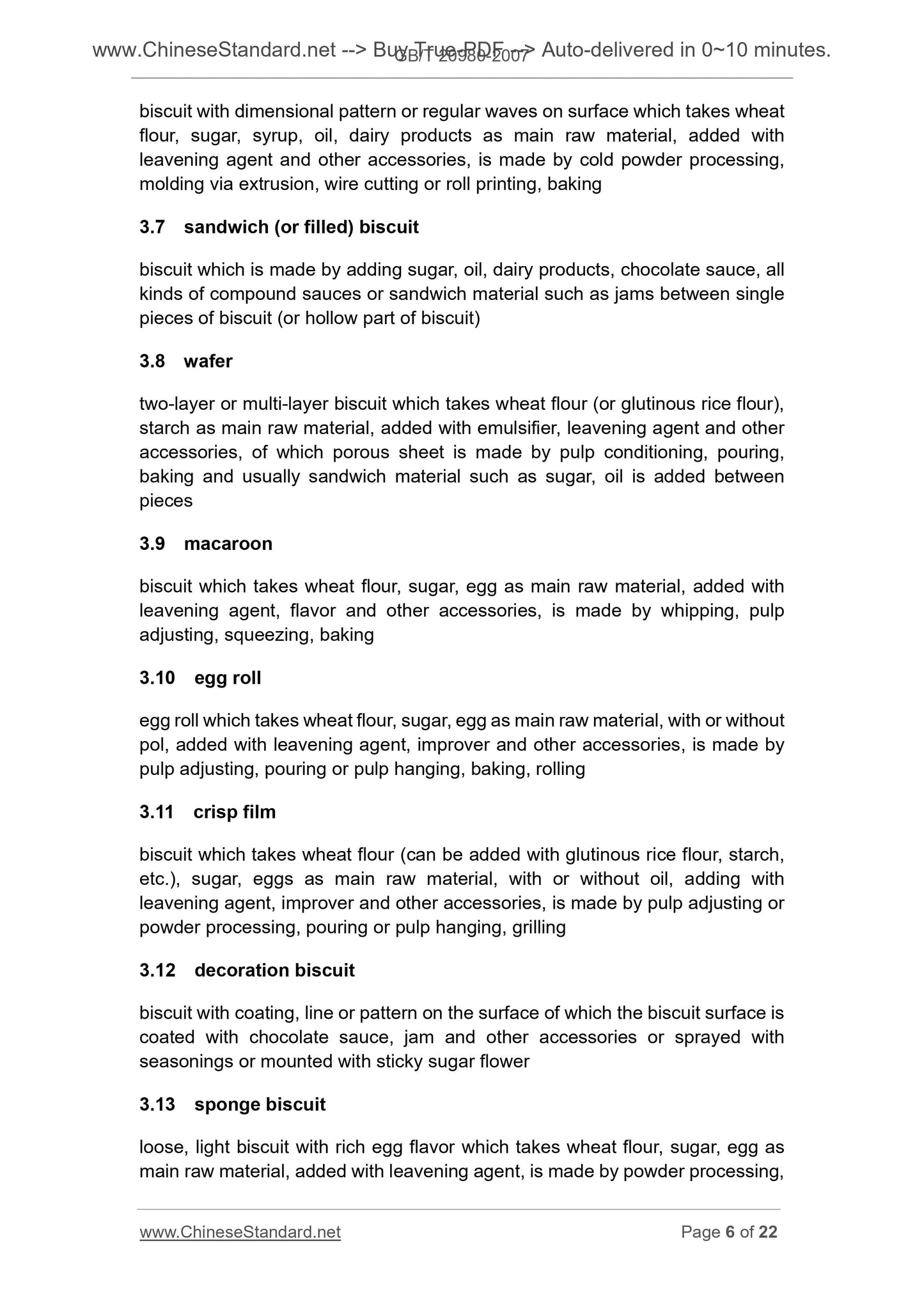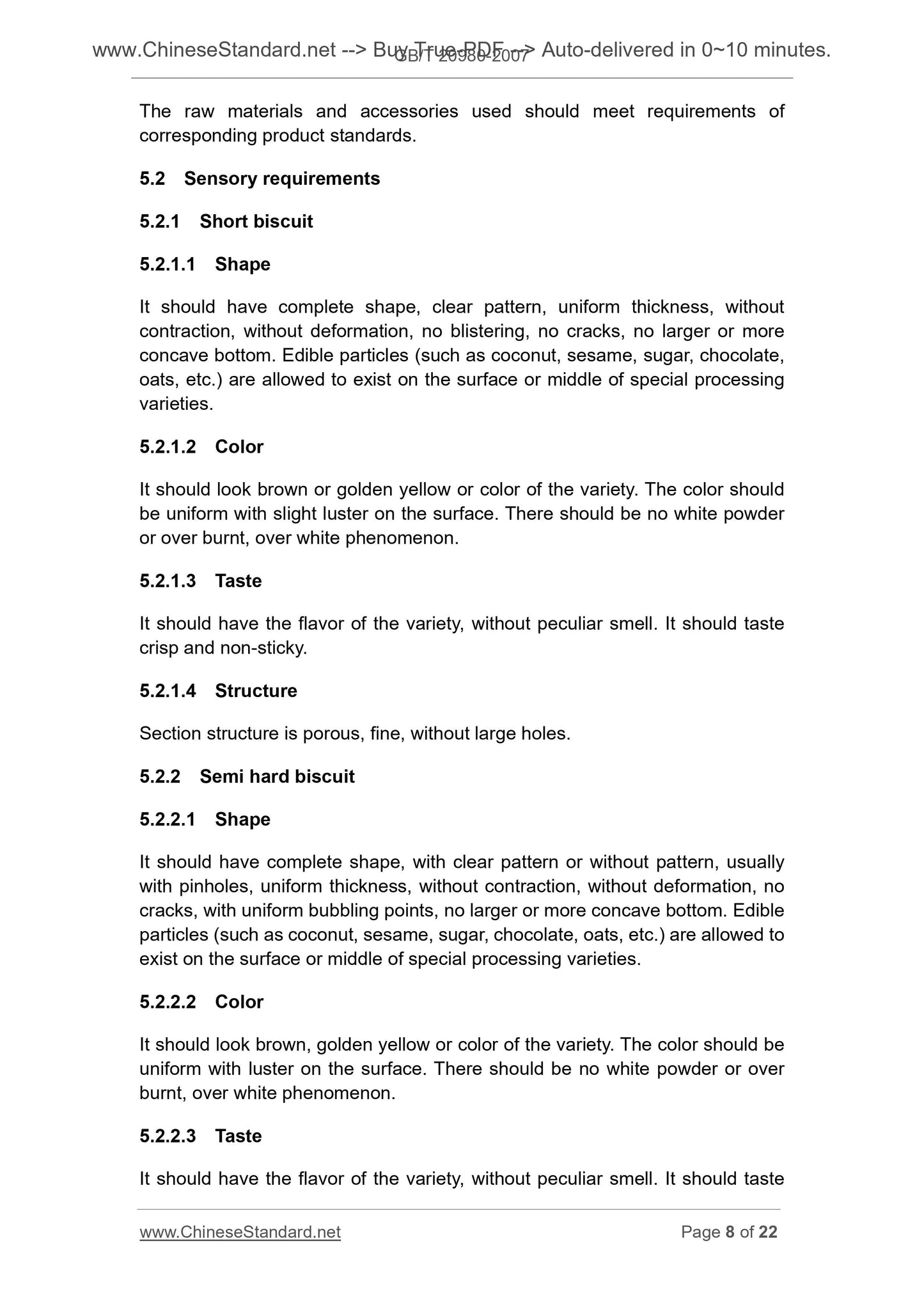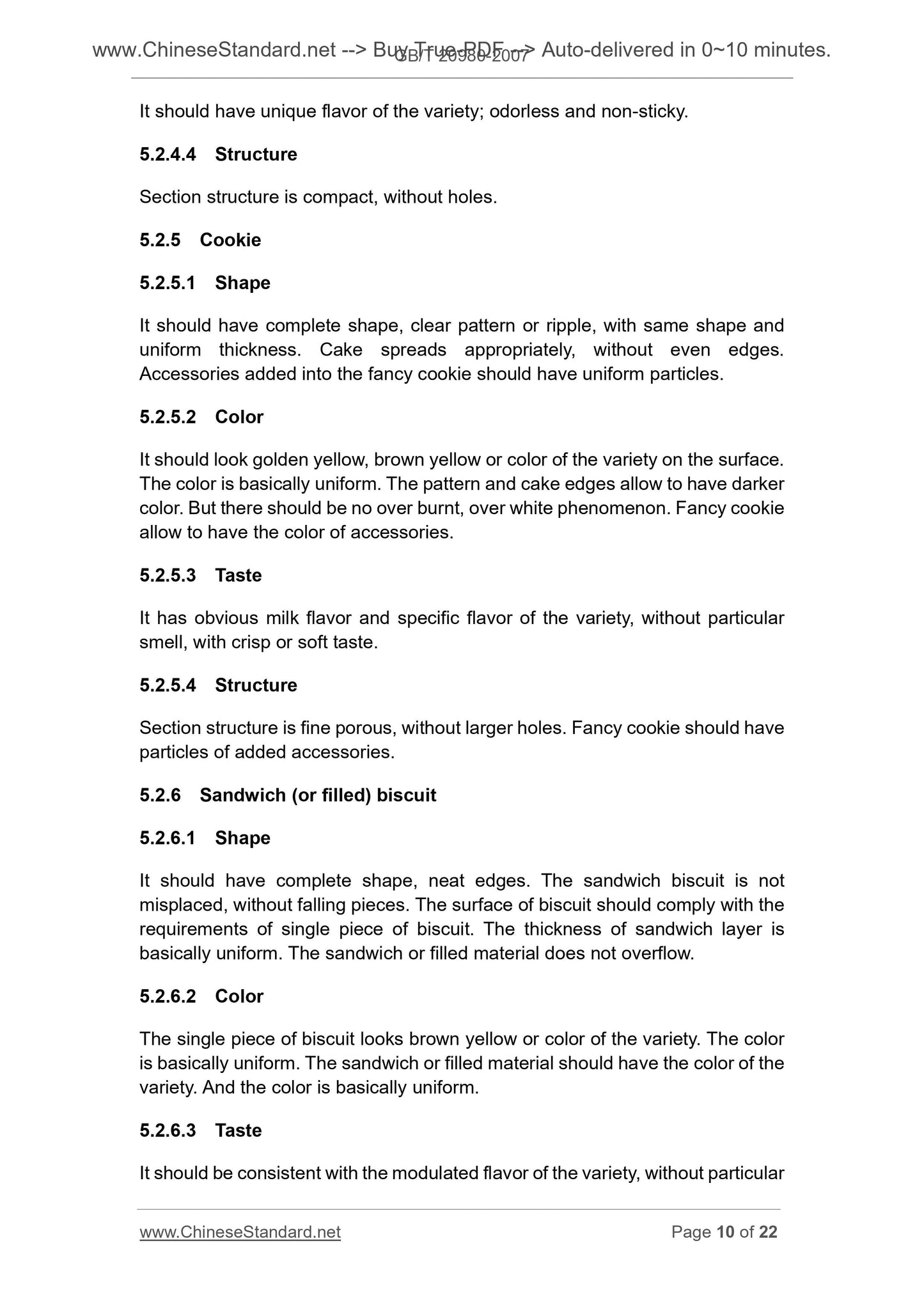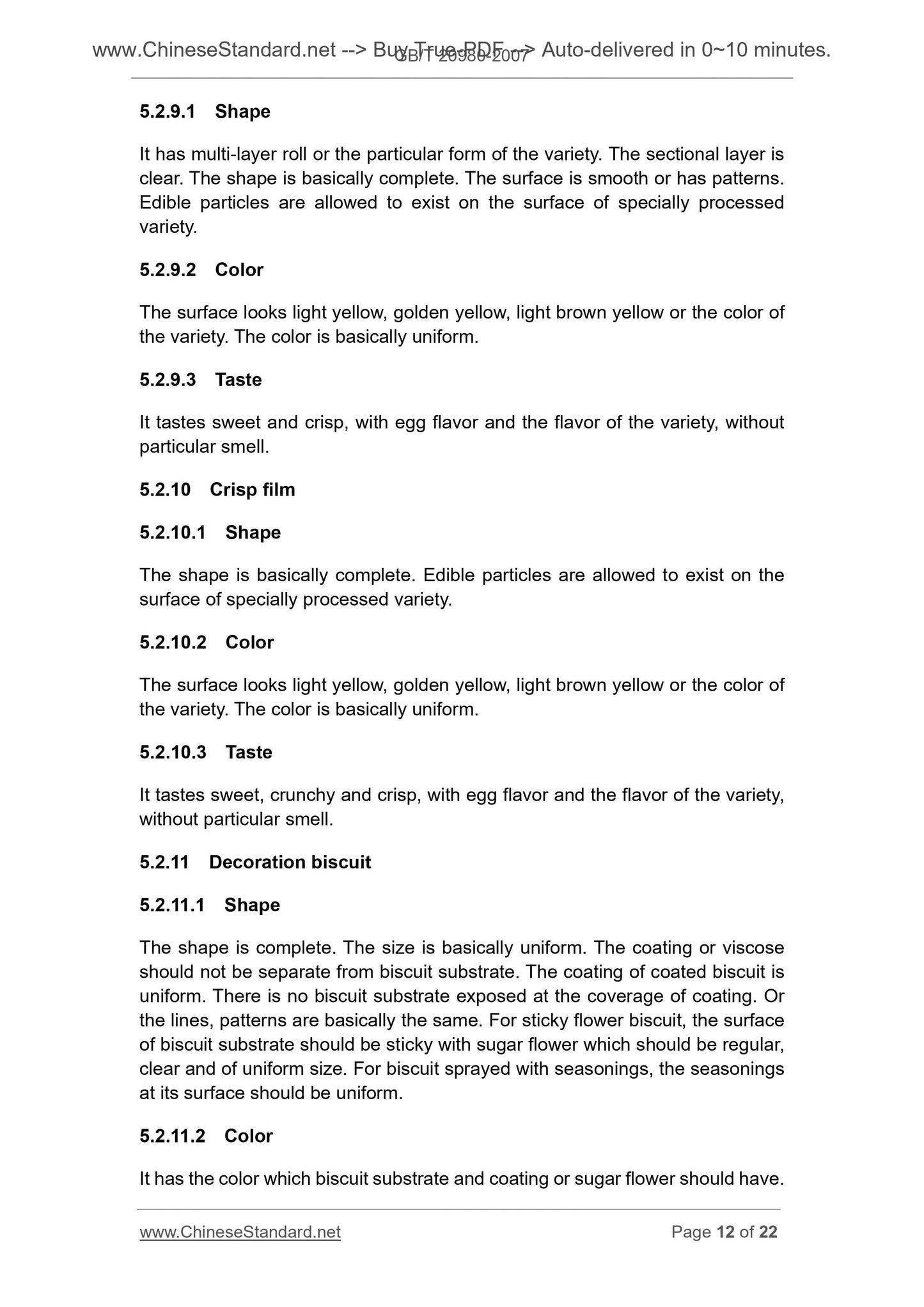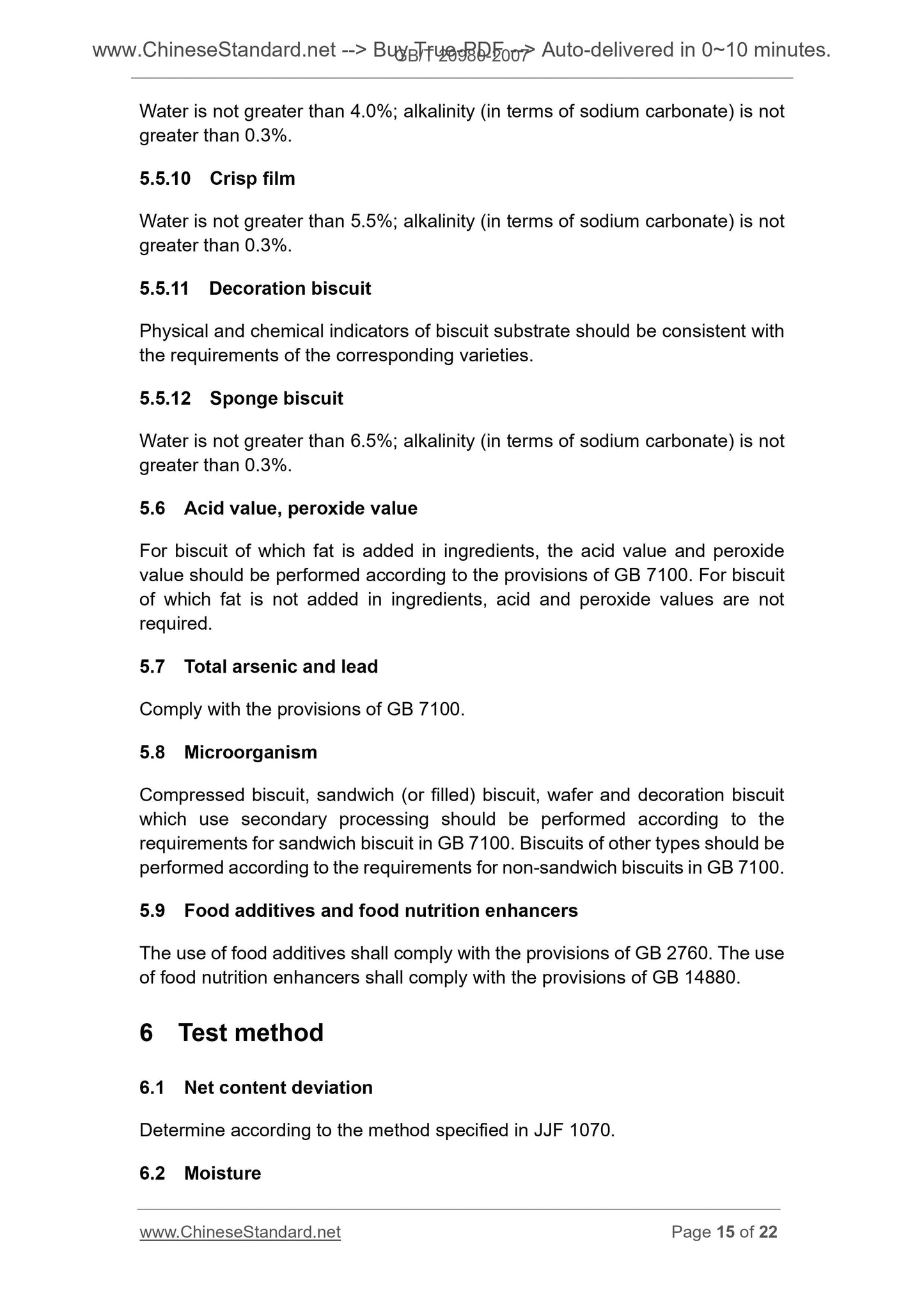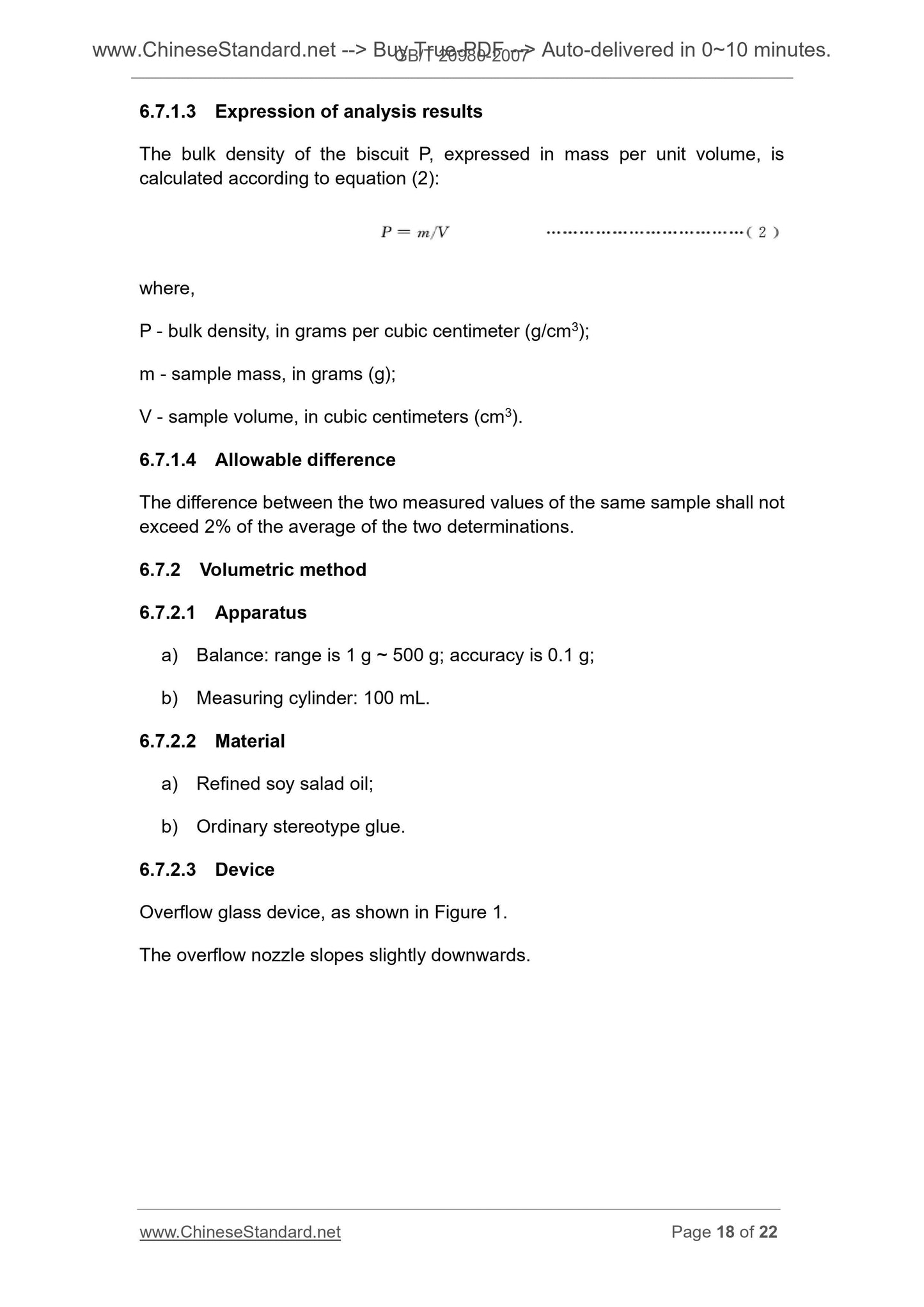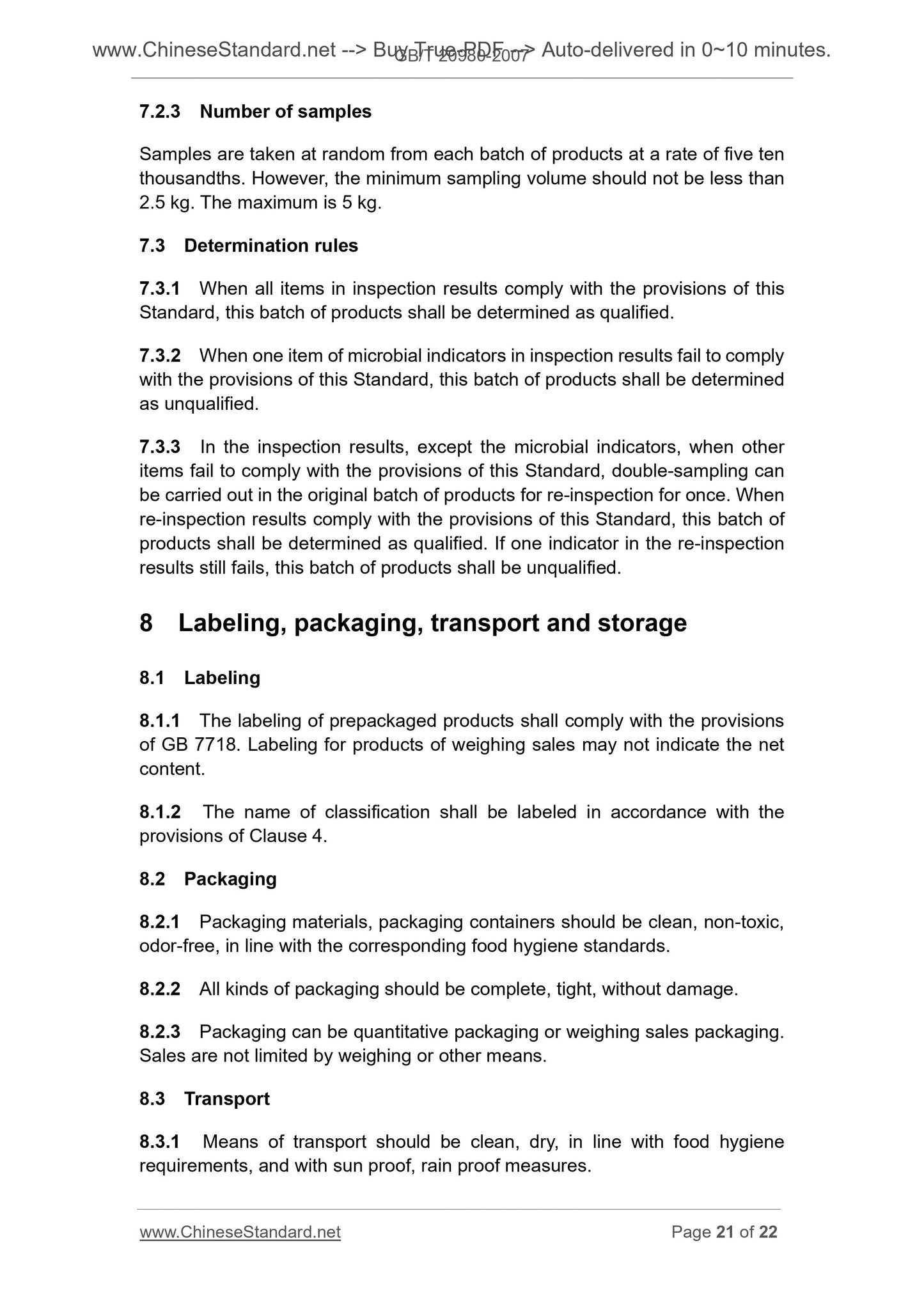1
/
of
11
PayPal, credit cards. Download editable-PDF and invoice in 1 second!
GB/T 20980-2007 English PDF (GBT20980-2007)
GB/T 20980-2007 English PDF (GBT20980-2007)
Regular price
$85.00 USD
Regular price
Sale price
$85.00 USD
Unit price
/
per
Shipping calculated at checkout.
Couldn't load pickup availability
Delivery: 3 seconds. Download true-PDF + Invoice.
Get QUOTATION in 1-minute: Click GB/T 20980-2007
Historical versions: GB/T 20980-2007
Preview True-PDF (Reload/Scroll if blank)
GB/T 20980-2007: Biscuit
GB/T 20980-2007
GB
NATIONAL STANDARD OF
THE PEOPLE’S REPUBLIC OF CHINA
ICS 67.060
X 28
Biscuit
饼干
ISSUED ON. JUNE 12, 2007
IMPLEMENTED ON. MAY 1, 2008
Issued by. General Administration of Quality Supervision, Inspection and
Quarantine;
Standardization Administration Committee.
Table of Contents
Foreword ... 3
1 Scope ... 4
2 Normative references ... 4
3 Terms and definitions ... 5
4 Classification ... 7
5 Technical requirements ... 7
6 Test method ... 15
7 Inspection rules ... 20
8 Labeling, packaging, transport and storage ... 21
Foreword
This Standard was formulated based on the integration of QB/T 1433.1-2005
Biscuits Short biscuits, QB/T 1433.2-2005 Biscuits Semihard biscuits, QB/T
1433.3-2005 Biscuits Fermented biscuits, QB/T 1433.4-2005 Biscuits
Compressed biscuits, QB/T 1433.5-2005 Cookies, QB/T 1433.6-2005 Biscuits
Sandwich biscuits, QB/T 1433.7-2005 Biscuits Wafer biscuits, QB/T 1433.8-
2005 Macaroon, QB/T 1433.9-2005 Biscuits Egg roll and crisp film, QB/T
1433.10-2005 Biscuits Decoration biscuits, QB/T 1433.11 Biscuits Sponge
biscuits.
Since the date of implementation of this Standard, QB/T 1433.1 ~ 1433.11-2005,
QB/T 1253-2005 and QB/T 1254-2005 are repealed simultaneously.
This Standard was proposed by China Light Industry Association.
This Standard shall be under the jurisdiction of National Food Fermentation
Standardization Center.
This Standard was drafted by China Bakery and Sugar Products Industry
Association.
The drafting organizations of this Standard. China Food Fermentation Industry
Research Institute, Qingdao Foodstuffs Co., Ltd., Guanshengyuan (Group) Co.,
Ltd., Kaiping Jia Shili Foods Co., Ltd., Zhuhai Kadu Jiuzhou Food Co., Ltd..,
Shanghai Danone Biscuits Foods Co., Ltd., Dingxin International Group,
Guangdong Wan Shifa Bakery Industry Co., Ltd., Kraft Foods (China) Limited,
Guangzhou Product Quality Supervision and Inspection Institute, Dongguan
XuJi Food Company Limited.
Main drafters of this Standard. Chen Yan, Zhu Nianlin, Li Peixu, Chu Daming,
Zhou Rongzhi, Zhou Weiwen, Ye Ming, Yan Kunxiong, Cheng Mian, Wu Yuluan,
Ma Hao.
This Standard was formulated for the first time.
Biscuit
1 Scope
This Standard specifies the terms and definitions, classification, technical
requirements, test methods, inspection rules, labeling, packaging, transport and
storage of biscuit.
This Standard is applicable to biscuit products irrespective of material.
2 Normative references
The following standards contain the provisions which, through reference in this
Standard, constitute the provisions of this Standard. For dated references,
subsequent amendments (excluding corrections) or revisions do not apply to
this Standard. However, the parties who enter into agreement based on this
Standard are encouraged to investigate whether the latest versions of these
documents are applicable. For undated reference documents, the latest
versions apply to this Standard.
GB/T 601, Chemical reagent--Preparations of STANDARD volumetric
solutions;
GB 2760, National Food Safety Standard - Standards for Uses of Food
Additives;
GB/T 5009.3, Method for determination of moisture in foods;
GB/T 5009.6, Method for determination of fat in foods;
GB 7100, National Food Safety Standard Biscuit;
GB 7718, National Food Safety Standard--Standard for nutrition labelling of
prepackaged foods;
GB/T 10786, Analytical methods of canned food;
GB/T 12456, Determination of total acid in foods (GB/T 12456-1990, neq ISO
750.1981);
GB 14880, National Food Safety Standard for the Use of Nutritional
Fortification Substances in Foods;
biscuit with dimensional pattern or regular waves on surface which takes wheat
flour, sugar, syrup, oil, dairy products as main raw material, added with
leavening agent and other accessories, is made by cold powder processing,
molding via extrusion, wire cutting or roll printing, baking
3.7 sandwich (or filled) biscuit
biscuit which is made by adding sugar, oil, dairy products, chocolate sauce, all
kinds of compound sauces or sandwich material such as jams between single
pieces of biscuit (or hollow part of biscuit)
3.8 wafer
two-layer or multi-layer biscuit which takes wheat flour (or glutinous rice flour),
starch as main raw material, added with emulsifier, leavening agent and other
accessories, of which porous sheet is made by pulp conditioning, pouring,
baking and usually sandwich material such as sugar, oil is added between
pieces
3.9 macaroon
biscuit which takes wheat flour, sugar, egg as main raw material, added with
leavening agent, flavor and other accessories, is made by whipping, pulp
adjusting, squeezing, baking
3.10 egg roll
egg roll which takes wheat flour, sugar, egg as main raw material, with or without
pol, added with leavening agent, improver and other accessories, is made by
pulp adjusting, pouring or pulp hanging, baking, rolling
3.11 crisp film
biscuit which takes wheat flour (can be added with glutinous rice flour, starch,
etc.), sugar, eggs as main raw material, with or without oil, adding with
leavening agent, improver and other accessories, is made by pulp adjusting or
powder processing, pouring or pulp hanging, grilling
3.12 decoration biscuit
biscuit with coating, line or pattern on the surface of which the biscuit surface is
coated with chocolate sauce, jam and other accessories or sprayed with
seasonings or mounted with sticky sugar flower
3.13 sponge biscuit
loose, light biscuit with rich egg flavor which takes wheat flour, sugar, egg as
main raw material, added with leavening agent, is made by powder processing,
The raw materials and accessories used should meet requirements of
corresponding product standards.
5.2 Sensory requirements
5.2.1 Short biscuit
5.2.1.1 Shape
It should have complete shape, clear pattern, uniform thickness, without
contraction, without deformation, no blistering, no cracks, no larger or more
concave bottom. Edible particles (such as coconut, sesame, sugar, chocolate,
oats, etc.) are allowed to exist on the surface or middle of special processing
varieties.
5.2.1.2 Color
It should look brown or golden yellow or color of the variety. The color should
be uniform with slight luster on the surface. There should be no white powder
or over burnt, over white phenomenon.
5.2.1.3 Taste
It should have the flavor of the variety, without peculiar smell. It should taste
crisp and non-sticky.
5.2.1.4 Structure
Section structure is porous, fine, without large holes.
5.2.2 Semi hard biscuit
5.2.2.1 Shape
It should have complete shape, with clear pattern or without pattern, usually
with pinholes, uniform thickness, without contraction, without deformation, no
cracks, with uniform bubbling points, no larger or more concave bottom. Edible
particles (such as coconut, sesame, sugar, chocolate, oats, etc.) are allowed to
exist on the surface or middle of special processing varieties.
5.2.2.2 Color
It should look brown, golden yellow or color of the variety. The color should be
uniform with luster on the surface. There should be no white powder or over
burnt, over white phenomenon.
5.2.2.3 Taste
It should have the flavor of the variety, without peculiar smell. It should taste
It should have unique flavor of the variety; odorless and non-sticky.
5.2.4.4 Structure
Section structure is compact, without h...
Get QUOTATION in 1-minute: Click GB/T 20980-2007
Historical versions: GB/T 20980-2007
Preview True-PDF (Reload/Scroll if blank)
GB/T 20980-2007: Biscuit
GB/T 20980-2007
GB
NATIONAL STANDARD OF
THE PEOPLE’S REPUBLIC OF CHINA
ICS 67.060
X 28
Biscuit
饼干
ISSUED ON. JUNE 12, 2007
IMPLEMENTED ON. MAY 1, 2008
Issued by. General Administration of Quality Supervision, Inspection and
Quarantine;
Standardization Administration Committee.
Table of Contents
Foreword ... 3
1 Scope ... 4
2 Normative references ... 4
3 Terms and definitions ... 5
4 Classification ... 7
5 Technical requirements ... 7
6 Test method ... 15
7 Inspection rules ... 20
8 Labeling, packaging, transport and storage ... 21
Foreword
This Standard was formulated based on the integration of QB/T 1433.1-2005
Biscuits Short biscuits, QB/T 1433.2-2005 Biscuits Semihard biscuits, QB/T
1433.3-2005 Biscuits Fermented biscuits, QB/T 1433.4-2005 Biscuits
Compressed biscuits, QB/T 1433.5-2005 Cookies, QB/T 1433.6-2005 Biscuits
Sandwich biscuits, QB/T 1433.7-2005 Biscuits Wafer biscuits, QB/T 1433.8-
2005 Macaroon, QB/T 1433.9-2005 Biscuits Egg roll and crisp film, QB/T
1433.10-2005 Biscuits Decoration biscuits, QB/T 1433.11 Biscuits Sponge
biscuits.
Since the date of implementation of this Standard, QB/T 1433.1 ~ 1433.11-2005,
QB/T 1253-2005 and QB/T 1254-2005 are repealed simultaneously.
This Standard was proposed by China Light Industry Association.
This Standard shall be under the jurisdiction of National Food Fermentation
Standardization Center.
This Standard was drafted by China Bakery and Sugar Products Industry
Association.
The drafting organizations of this Standard. China Food Fermentation Industry
Research Institute, Qingdao Foodstuffs Co., Ltd., Guanshengyuan (Group) Co.,
Ltd., Kaiping Jia Shili Foods Co., Ltd., Zhuhai Kadu Jiuzhou Food Co., Ltd..,
Shanghai Danone Biscuits Foods Co., Ltd., Dingxin International Group,
Guangdong Wan Shifa Bakery Industry Co., Ltd., Kraft Foods (China) Limited,
Guangzhou Product Quality Supervision and Inspection Institute, Dongguan
XuJi Food Company Limited.
Main drafters of this Standard. Chen Yan, Zhu Nianlin, Li Peixu, Chu Daming,
Zhou Rongzhi, Zhou Weiwen, Ye Ming, Yan Kunxiong, Cheng Mian, Wu Yuluan,
Ma Hao.
This Standard was formulated for the first time.
Biscuit
1 Scope
This Standard specifies the terms and definitions, classification, technical
requirements, test methods, inspection rules, labeling, packaging, transport and
storage of biscuit.
This Standard is applicable to biscuit products irrespective of material.
2 Normative references
The following standards contain the provisions which, through reference in this
Standard, constitute the provisions of this Standard. For dated references,
subsequent amendments (excluding corrections) or revisions do not apply to
this Standard. However, the parties who enter into agreement based on this
Standard are encouraged to investigate whether the latest versions of these
documents are applicable. For undated reference documents, the latest
versions apply to this Standard.
GB/T 601, Chemical reagent--Preparations of STANDARD volumetric
solutions;
GB 2760, National Food Safety Standard - Standards for Uses of Food
Additives;
GB/T 5009.3, Method for determination of moisture in foods;
GB/T 5009.6, Method for determination of fat in foods;
GB 7100, National Food Safety Standard Biscuit;
GB 7718, National Food Safety Standard--Standard for nutrition labelling of
prepackaged foods;
GB/T 10786, Analytical methods of canned food;
GB/T 12456, Determination of total acid in foods (GB/T 12456-1990, neq ISO
750.1981);
GB 14880, National Food Safety Standard for the Use of Nutritional
Fortification Substances in Foods;
biscuit with dimensional pattern or regular waves on surface which takes wheat
flour, sugar, syrup, oil, dairy products as main raw material, added with
leavening agent and other accessories, is made by cold powder processing,
molding via extrusion, wire cutting or roll printing, baking
3.7 sandwich (or filled) biscuit
biscuit which is made by adding sugar, oil, dairy products, chocolate sauce, all
kinds of compound sauces or sandwich material such as jams between single
pieces of biscuit (or hollow part of biscuit)
3.8 wafer
two-layer or multi-layer biscuit which takes wheat flour (or glutinous rice flour),
starch as main raw material, added with emulsifier, leavening agent and other
accessories, of which porous sheet is made by pulp conditioning, pouring,
baking and usually sandwich material such as sugar, oil is added between
pieces
3.9 macaroon
biscuit which takes wheat flour, sugar, egg as main raw material, added with
leavening agent, flavor and other accessories, is made by whipping, pulp
adjusting, squeezing, baking
3.10 egg roll
egg roll which takes wheat flour, sugar, egg as main raw material, with or without
pol, added with leavening agent, improver and other accessories, is made by
pulp adjusting, pouring or pulp hanging, baking, rolling
3.11 crisp film
biscuit which takes wheat flour (can be added with glutinous rice flour, starch,
etc.), sugar, eggs as main raw material, with or without oil, adding with
leavening agent, improver and other accessories, is made by pulp adjusting or
powder processing, pouring or pulp hanging, grilling
3.12 decoration biscuit
biscuit with coating, line or pattern on the surface of which the biscuit surface is
coated with chocolate sauce, jam and other accessories or sprayed with
seasonings or mounted with sticky sugar flower
3.13 sponge biscuit
loose, light biscuit with rich egg flavor which takes wheat flour, sugar, egg as
main raw material, added with leavening agent, is made by powder processing,
The raw materials and accessories used should meet requirements of
corresponding product standards.
5.2 Sensory requirements
5.2.1 Short biscuit
5.2.1.1 Shape
It should have complete shape, clear pattern, uniform thickness, without
contraction, without deformation, no blistering, no cracks, no larger or more
concave bottom. Edible particles (such as coconut, sesame, sugar, chocolate,
oats, etc.) are allowed to exist on the surface or middle of special processing
varieties.
5.2.1.2 Color
It should look brown or golden yellow or color of the variety. The color should
be uniform with slight luster on the surface. There should be no white powder
or over burnt, over white phenomenon.
5.2.1.3 Taste
It should have the flavor of the variety, without peculiar smell. It should taste
crisp and non-sticky.
5.2.1.4 Structure
Section structure is porous, fine, without large holes.
5.2.2 Semi hard biscuit
5.2.2.1 Shape
It should have complete shape, with clear pattern or without pattern, usually
with pinholes, uniform thickness, without contraction, without deformation, no
cracks, with uniform bubbling points, no larger or more concave bottom. Edible
particles (such as coconut, sesame, sugar, chocolate, oats, etc.) are allowed to
exist on the surface or middle of special processing varieties.
5.2.2.2 Color
It should look brown, golden yellow or color of the variety. The color should be
uniform with luster on the surface. There should be no white powder or over
burnt, over white phenomenon.
5.2.2.3 Taste
It should have the flavor of the variety, without peculiar smell. It should taste
It should have unique flavor of the variety; odorless and non-sticky.
5.2.4.4 Structure
Section structure is compact, without h...
Share
